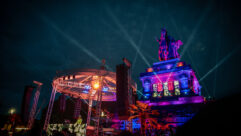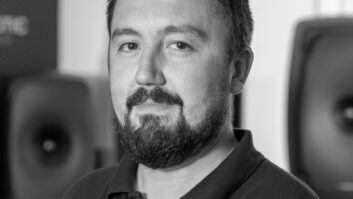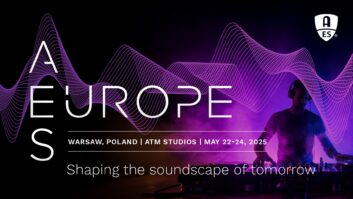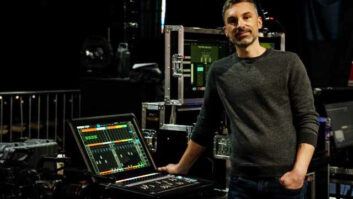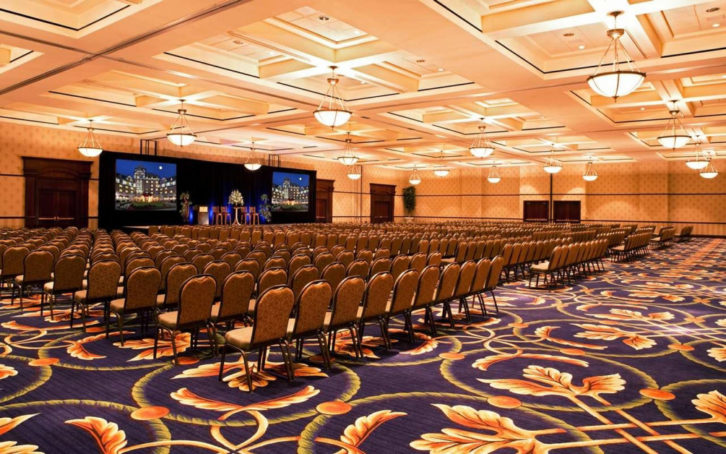
SVC Podcast – Show Notes – Show 126-2:
In this edition of the SVC Podcast, SVC Contributing Editor Bennett Liles continues his talk with project manager Jim Hogan of IES Communications in Roanoke, Virginia about his firm’s replacement of an outdated audio system in the Hotel Roanoke & Convention Center. Jim discusses wireless microphone frequency coordination, media playback capability and the intense work when the crew got to the system change-over point.
Links of interest:
- The Bose PM8500N amplifier
- Bose ControlSpace Designer software
- Audinate, the home of the Dante digital networking technology
Download Podcast Here:
https://s3.amazonaws.com/nb-svc/public/public/126-2_IES_Comm_Roanoke_Hog…
From Sound & Video Contractor Magazine, this is the SVC Podcast with Jim Hogan of IES Communications. Show notes for the podcast are available on the web site of Sound & Video Contractor Magazine at svconline.com.
To bring the sound system up to present day technology at the Hotel Roanoke and Convention Center, IES Communications installed Dante-enabled SymNet DSP, Bose speakers and Shure wireless mics. Project manager Jim Hogan is back to finish up his account on how they got it all in and up and running. Coming up right now on the SVC Podcast.
Jim, thank you for being back with us for part two on the SVC Podcast from IES Communications in Roanoke, Virginia; the big sound system upgrade at the Hotel Roanoke and Convention Center, a sixty-three thousand square foot place with a lot of ground to cover. In getting the old system out first, how much work was involved in that part of it?
Well, there was a considerable amount of old gear that we had to remove. The head end rack was four bays full of gear that we really condensed down to about two bays, but we had to get it all out and remove it from the site. Fortunately, it was pretty easy access getting things in and out. [Timestamp: 1:29]
And what was the particular attraction of the Bose Modular Line Array speakers for this one? Had you used those before or was it just a matter of the specs being right?
Actually I was the one who chose to use the modular array system, and the reason being is that we had done several projects where there were highly reverberant spaces that these modular array boxes are very well behaved and they do a really good job of controlling and doing vocal reinforcement or speech intelligibility for highly reverberant spaces. I’ve been using these for several years. They’re reasonably priced and they do a great job. They’re well behaved. I was actually very amazed the first time I heard them, the first time the Bose rep brought them around and let me listen to them. Bose has always been famous for their small loudspeakers and the guy brought these little skinny, long – they’re about 40 inches long per box – and when I walked around to the edge of it and the sound just disappeared, I said this is pretty awesome. The physics behind it – the way they work – when you stack them up essentially your pattern is as tall as your speaker stack is, so they work well and they’re affordable. [Timestamp: 2:51]
And they’re almost invisible in most environments. Their shape and size really helps those to blend right into the background.
They almost disappear. They’re, as you say, very small in size and even when you put a tall array together. We did two different systems in here using the modular arrays, one being the lecture hall. We used a triple stack in there and that enabled us to get good speech intelligibility to the back of the room without a lot of problem, and then we also put a small outside system. The MA12EX’s are weather resistant, and we had a patio area that they use for a lot of weddings and private parties. We took a double stack, mounted them onto posts of a cover and you can’t see them when you get on the other side of the area. It’s their patio and deck area. We used the dark ones there and it’s some dark wood posts and you can’t hardly see them. [Timestamp: 3:55]
And you also put in a Shure wireless mic system. Were there any frequency coordination issues with that? Did you use the coordination software like the Shure Wireless Workbench?
Well, we did use the Wireless Workbench. We also used a couple of the Dante features in a few of them. They actually cut back tremendously from what they had originally planned to use on the wireless system. Originally there was plans for about 20 more systems than we ended up putting in. We put in about 12 of them. There were originally, I think, going to be 20 more but due to some financial constraints – they already had a few. I think they already had about half a dozen of the digital systems in place, and the people here, they knew what they wanted. They were happy. They knew that this worked and obviously for us it’s great. In a couple of remote locations that we needed to reach using the Dante made it a lot easier to use those as well. [Timestamp: 4:55]
Yeah, it sounds like the wireless mic system they had in there was probably not quite as old as the original equipment?
Actually I believe the oldest systems that they had were some ULX systems that we replaced. We pulled out, I think, about four of those, but none of that equipment was original equipment. That was stuff that they’d added over the years and I think they had put in a couple of systems in the last couple of years and they’d put in a couple of ULX-D’s. So they were already aware of what was possible with that. [Timestamp: 5:25]
What did you have to do on the power? Was there any modification that had to be made to add capacity for powering all the new gear?
Actually the power is now more efficient than it was. It’s not drawing as much current as it was before we started. So it was all in place and it made it real easy for them, made it real easy for us, too, so it was all right there. They didn’t have to do any upgrades, which was great. [Timestamp: 5:46]
Well, I know that’s a busy place and you had a lot to do to get the whole thing ready in between scheduled events. How big a crew did you have for this and how did the testing go when it was all hooked up?
Well the install, actually because of having to coordinate and work around events because the place gets so busy, we pretty much worked with a six-man crew throughout the project and we bumped it up a couple guys. We spent one entire weekend doing a switch over when we actually killed the old system and switched it over and hooked up the new system. We only had five days to make that switch over, so we bumped it up a little bit there when we had to do the head-in part so we could make sure we got it up and going without any issues and being able to meet their crazy schedule around here. [Timestamp: 6:37]
And they’ve got pretty much automated mixing capability now but what are the various sources that they can put up besides the mics?
It’s somewhat limited. I guess throughout the convention area they don’t do a lot of additional. They do a little bit of video, not a ton of video, which I know that’s something that they’re working towards in the near future, but primarily mic and line level now. In the lecture hall we did do a full 7.1 surround sound system there and we put in a Blu-ray system with a Blu-ray player with a digital input and a surround sound processor. We used an Extron surround sound processor and interfaced it with the Bose amps and it turned out nice. So we’ve got awesome surround sound in the lecture hall. [Timestamp: 7:26]
Of course, they can have a lot of different things going on there at the same time. Do they ever bring in a truck and televise anything out of there?
Well, they have full capability. There is separate TV infrastructure that’s been here really as long as the building has. It’s aged. They don’t use it a lot, but they have the capabilities. That cable is already existing and we left it independent. We didn’t touch that. We used it a little bit to cheat – sometimes when they want to get some special cabling across the room or something, but it’s a broadcast cable infrastructure in place. [Timestamp: 8:01]
Well, that’s a future project for you then.
That’s it. We’re hoping that one day we’ll be able to replace that as well, especially with the video aspect of things. And of course things are changing so much these days, we can probably use some of the existing network cabling that we put in to help with that. [Timestamp: 8:20]
Just future proofing it is enough of a big job I’m sure.
It’s a challenge. It really is.
So what’s coming up next?
We do a lot of work in the K-12 business. We’re currently working on about three different high school projects. We do some stuff with the local universities around here. We’ve got a couple of fairly good-sized university projects that are coming up in the near future. Probably the biggest one that I’m working on is when I’m partnering with one of our other offices. And we’re doing a large hospital project out in El Paso, Texas. That’s the biggest one that we’re currently engaging in. [Timestamp: 8:59]
It’s been fun hearing about this one and thanks for telling us about it. Jim Hogan with IES Communications in Roanoke, Virginia and the Hotel Roanoke and Convention Center total sound system renovation. I’m sure they’ll be calling you guys back when they upgrade the video there.
Sounds good. Thank you so much for your time.
Thank you for being here with us for the SVC Podcast with Jim Hogan of IES Communications. Show notes are available on the website of Sound & Video Contractor Magazine at svconline.com. Be with us again next time on the SVC Podcast.





